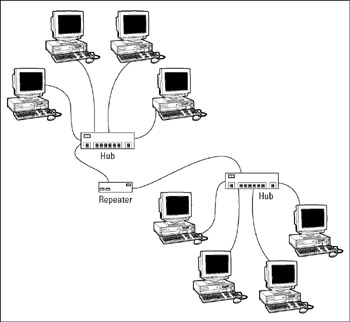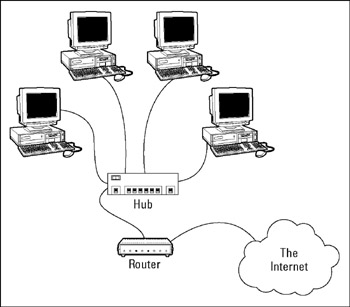Other Network Devices
In addition to network interface cards, cables, and hubs or switches, some networks may require one or more of the devices described in the following sections.
Repeaters
A repeater is a gizmo that gives your network signals a boost so that the signals can travel farther. It's kind of like the Gatorade stations in a marathon. As the signals travel past the repeater, they pick up a cup of Gatorade, take a sip, splash the rest of it on their heads, toss the cup, and hop in a cab when they're sure that no one is looking.
You need a repeater when the total length of a single span of network cable is larger than the maximum allowed for your cable type:
| Cable | Maximum Length |
|---|---|
| 10Base2 (coaxial) | 185 meters or 606 feet |
| 10/100BaseT (twisted-pair) | 100 meters or 328 feet |
For coaxial cable, the cable lengths given here apply to cable segments-not to individual lengths of cable. A segment is the entire run of cable from one terminator to another and may include more than one computer. In other words, if you connect ten computers with 25-foot lengths of thin coaxial cable, the total length of the segment is 225 feet. (Made you look! Only nine cables are required to connect ten computers-that's why it's not 250 feet.)
For 10BaseT or 100BaseT cable, the 100-meter length limit applies to the cable that connects a computer to the hub or the cable that connects hubs to each other when hubs are daisy-chained with twisted-pair cable. In other words, you can connect each computer to the hub with no more than 100 meters of cable, and you can connect hubs to each other with no more than 100 meters of cable.
Figure 5-7 shows how you can use a repeater to connect two groups of computers that are too far apart to be strung on a single segment. When you use a repeater like this, the repeater divides the cable into two segments. The cable length limit still applies to the cable on each side of the repeater.

Figure 5-7: Using a repeater.
Ponder these points when you lie awake tonight thinking about repeaters:
-
Repeaters are used only with Ethernet networks wired with coaxial cable; twisted-pair networks don't use repeaters.
TECHNICAL STUFF Actually, that's not quite true: twisted-pair does use repeaters. It's just that the repeater isn't a separate device. In a twisted-pair network, the switch is a multiport repeater. That's why the cable used to attach each computer to the switch is considered a separate segment.
-
Some 10/100BaseT switches have a BNC connector on the back. This BNC connector is a Thinnet repeater that enables you to attach a full 185-meter Thinnet segment. The segment can attach other computers, 10BaseT hubs, or a combination of both.
-
A basic rule of Ethernet life is that a signal can't pass through more than three repeaters on its way from one node to another.
TECHNICAL STUFF You can have more than three repeaters or switches. If you do, you have to carefully plan the network cabling so that the three-repeater rule isn't violated.
-
A two-port 10Base2 repeater costs about $200. (Sheesh! I guess that's one of the reasons few people use coaxial cable anymore.)
-
Repeaters are legitimate components of a by-the-book Ethernet network. They don't extend the maximum length of a single segment; they just enable you to tie two segments together.
Warning Beware of the little black boxes that claim to extend the segment limit beyond the 185-meter limit for Thinnet or the 100-meter limit for 10/100BaseT cable. These products usually work, but playing by the rules is better.
Bridges
A bridge is a device that connects two networks. Bridges are used to partition one large network into two smaller networks for performance reasons.
| Tip | Think of a bridge as a kind of smart repeater. Repeaters listen to signals coming down one network cable, amplify them, and send them down the other cable. They do this blindly, paying no attention to the content of the messages they repeat. |
In contrast, a bridge is a little smarter about the messages that come down the pike. For starters, most bridges can listen to the network and automatically figure out the address of each computer on both sides of the bridge. Then the bridge can inspect each message that comes from one side of the bridge and broadcast it on the other side of the bridge, but only if the message is intended for a computer that's on the other side.
This key feature enables bridges to partition a large network into two smaller, more efficient networks. Bridges work best in networks that are highly segregated. For example, your network may consist of two distinct groups of users: the Marketing department and the Accounting department, each with its own servers.
A bridge lets you partition this network so that the Marketing side of the network isn't bogged down by Accounting, and vice versa. The bridge automatically learns which computers are on each side of the bridge and forwards messages from the one side to the other only when necessary. The overall performance of both networks improves, although the performance of any network operation that has to travel over the bridge slows down a bit.
Here are a few additional thoughts to consider about bridges:
-
Some bridges can translate the messages from one format to another.
For example, if the Marketing folks build their network with Ethernet and the accountants use Token Ring, a bridge can tie the two together.
You can get a basic bridge to partition two Ethernet networks for about $500. More-sophisticated bridges can cost $5,000 or more.
Routers
A router is like a bridge, but with a key difference: Bridges use actual hardware addresses (known as MAC addresses) to tell which network node each message is sent to so that it can forward the message to the appropriate segment. However, a bridge can't look inside the message to see what type of information is being sent. A router can. As a result, routers work at a higher level than bridges. Thus, routers can perform additional tasks, such as filtering packets based on their content. (Many routers also have built-in bridging functions, so routers are often used as bridges.)
| Tip | You can configure a network with several routers that can work cooperatively together. For example, some routers can monitor the network to determine the most efficient path for sending a message to its ultimate destination. If a part of the network is extremely busy, a router can automatically route messages along a less-busy route. In this respect, the router is kind of like a traffic reporter flying in a helicopter. The router knows that the 101 is bumper to bumper all the way through Sunnyvale, so it sends the message on the 280 instead. |
Here's some additional information about routers:
-
Routers used to be expensive and used only on large networks. However, the price of small routers has dropped substantially in recent years, so they're now becoming common even on small networks.
-
The functional distinctions between bridges and routers-and switches and hubs, for that matter-get blurrier all the time. Multifunction routers (which combine the functions of routers, bridges, hubs, and switches) are often used to handle some chores that used to require separate devices.
-
Some routers are nothing more than computers with delusions of grandeur-along with several network interface cards and special software to perform the router functions.
-
Routers can also connect networks that are geographically distant from each other by using a phone line (using modems) or ISDN.
-
One of the main reasons for using routers is to connect a LAN to the Internet. Figure 5-8 shows a router used for this purpose.

Figure 5-8: Using a router to connect a LAN to the Internet.